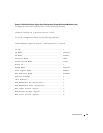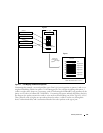
Quality of Service 139
7
Quality of Service
This section includes the following subsections:
• "Class of Service Queuing" on page 139
• "Differentiated Services" on page 143
Class of Service Queuing
The Class of Service (CoS) feature lets you give preferential treatment to certain types of traffic over
others. To set up this preferential treatment, you can configure the ingress ports, the egress ports,
and individual queues on the egress ports to provide customization that suits your environment.
The level of service is determined by the egress port queue to which the traffic is assigned. When
traffic is queued for transmission, the rate at which it is serviced depends on how the queue is
configured and possibly the amount of traffic present in other queues for that port.
Some traffic is classified for service (i.e., packet marking) before it arrives at the switch. If you decide
to use these classifications, you can map this traffic to egress queues by setting up a CoS Mapping
table.
Each ingress port on the switch has a default priority value (set by configuring VLAN Port Priority in
the Switching sub-menu) that determines the egress queue its traffic gets forwarded to. Packets that
arrive without a priority designation, or packets from ports you’ve identified as “untrusted,” get
forwarded according to this default.
Ingress Port Configuration
Trusted and Untrusted Ports/CoS Mapping Table
The first task for ingress port configuration is to specify whether traffic arriving on a given port is
“trusted” or “untrusted.”
A trusted port means that the system will accept at face value a priority designation within arriving
packets. You can configure the system to trust priority designations based on one of the following
fields in the packet header:
• 802.1 Priority: values 0-7
•IP DSCP: values 0-63
You can also configure an ingress port as untrusted, where the system ignores priority designations of
incoming packets and sends the packet to a queue based on the ingress port’s default priority.


















